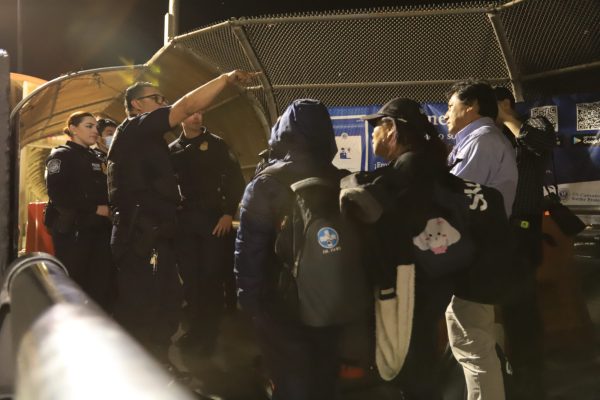Immigration viewed as ‘lifeline’ in some states, cities desperate to bolster population, labor force

Customs and Border Protection agents question families who have presented themselves at the Paso del Norte bridge to request asylum (Corrie Boudreaux for Source New Mexico).
As southern border states struggle with a record flow of asylum-seekers, major destination cities such as Chicago, Denver and New York City continue to ask for more federal help to handle the bus riders sent by Texas and Arizona.
“Our cities are working shoulder-to-shoulder to support newcomers, but it’s time for the federal government to increase work authorization, create a coordinated entry strategy, and provide more federal dollars,” Denver Democratic Mayor Mike Johnston wrote in a recent statement.

Last week, as congressional leaders wrestled with potential solutions as part of a larger spending agreement, a former top national immigration official offered a proposal: Fund basic help for migrants at the border and in destination cities, send them where they’re wanted and can get jobs, and make quick decisions on asylum to discourage mass entry.
Quick decisions are key, said Doris Meissner, who headed the former U.S. Immigration and Naturalization Service during the Clinton administration. She co-authored a new report released by the Migration Policy Institute, a think tank in Washington, D.C., that analyzes immigration policy.
“If you can make decisions in weeks or months instead of years, you can really have a functioning system,” Meissner said in an interview. “The problem right now is these decisions take years to make and by the time you get a decision, people have already sunk roots in the community and removal becomes far more unlikely.”
The proposal is something border communities in Texas very much want, since state officials have been hostile to any help for migrants crossing the border, said David Stout, a Democratic county commissioner in El Paso County.
The funding and coordination proposed by MPI and Meissner “are exactly the kind of solutions we need and that Republicans have been blocking,” Stout said. “We are trying our best at the local level, with some federal support, but it’s difficult with interference on the part of some political leaders and some states like Texas.”
As policymakers search for answers, states have increased confrontations over the issue in recent weeks.
This month, New York City sued charter bus companies used by Texas to send migrants, seeking $708 million in costs for caring for the new residents. New Jersey Democratic Gov. Phil Murphy warned bus operators from Louisiana and Texas not to drop off passengers in that state without notice; many have done so to avoid New York City restrictions.
Texas continued on its course of harsher enforcement, with Republican Gov. Greg Abbott signing a bill into law last month that makes illegal border crossing a state crime, allowing police and National Guard units to make arrests. The law is set to go into effect in March, but the Department of Justice has filed a lawsuit to block it.
The state this month seized control of a public park on the border despite the protests of local officials to use as a staging area for arrests and installation of border barriers. The DOJ on Friday asked the U.S. Supreme Court to intervene, saying the state was blocking border patrol access to the area.
Some states welcome migrants
A new border system could include the coordinated movement of asylum-seekers with valid cases to places that really want them, “not just to shelters in New York,” Meissner said.
“There are areas throughout the country where immigration has become a lifeline in terms of maintaining population levels and younger workers coming into the labor market.”
Cities that have recently called for more immigrant to fill jobs include Erie, Pennsylvania, and Topeka, Kansas, which have Democratic mayors. Both declined to comment for this story on whether they would participate in a program for asylum-seekers.
The Pittsburgh area, which has seen thousands of new immigrants arriving from the border in recent years, has a decade-old program to welcome them as one tool to halt population decline. Last year, leaders there prepared for the arrival of a busload of migrants, but that did not happen.
Even Republican states have been rethinking the need for more legal immigration to address the issues of aging populations and labor shortages.
Alaska restarted a long-dormant refugee assistance program to welcome about 700 Ukrainian refugees and help fill a shortage of skilled labor, said Catherine Muñoz, the state’s acting labor commissioner. She wasn’t sure whether the state would participate in a program for asylum-seekers.
The Republican governors of Indiana and Utah wrote an editorial last year calling for state-sponsored immigration to fill needed jobs.
Whether the Migration Policy Institute recommendations will gain traction is hard to say. The Department of Homeland Security did not immediately respond to a request for comment, but Meissner said the changes wouldn’t require new laws and could be paid for with border security funding now being negotiated by Congress.
No easy answers
Border crossings remained near record levels in October and November, the latest figures available, with about 240,000 people trying to cross the border illegally each month.
Along the U.S.-Mexico border, states vary wildly in their financial support for groups that assist migrants, the Migration Policy Institute report noted. Researchers traveled to cities in Arizona, California and Texas over a six-month period last year to observe conditions and procedures.
California has allocated $1 billion over four years to help asylum-seekers through service providers in the San Diego area, the report noted.
In Texas, the report said, state officials have increased police and National Guard presence on the border rather than aid for agencies that serve asylum-seekers.
One reason for chaos in the transportation of migrants from the border: new arrivals of people from countries such as Venezuela and Nicaragua without family ties in the United States, said Abel Nuñez, director of the Central American Resource Center in Washington, D.C., a group that helps greet buses of migrants from Texas and other states.
“I agree that there needs to be more funding for a coordinated effort to get the migrants from the border to the interior,” Nuñez said. “The process should include parts of the country that desperately need more workers and not just the large cities.”
He advised caution, though, on quickening the pace of asylum cases. “It needs to be done in the appropriate way and not just to limit the amount of people that access it,” Nuñez said.
But Meissner said shorter decision times on asylum will discourage migrants with iffy cases from flooding the border, hoping for years of quasi-legal status as their cases wind through clogged courts, Meissner said.
“It should implant a new psychology,” Meissner said. “If it doesn’t lead to being in the country for years, then that becomes known quite quickly, and it’s more likely that people that are coming are the ones in need.”
Editor's note: This story first appeared on Stateline, which is part of States Newsroom, a nonprofit news network supported by grants and a coalition of donors as a 501c(3) public charity. Stateline maintains editorial independence. Contact Editor Scott S. Greenberger for questions: info@stateline.org. Follow Stateline on Facebook and Twitter.
You must be logged in to post a comment Login